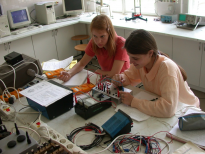Szegedi Tudományegyetem - Ahol tudás és szándék találkozik
 Régi doktori képzéses anyagok
Régi doktori képzéses anyagok
Chair: Prof. Ferenc Fülöp DSc, MHAS
Institute of Pharmaceutical Chemistry
H–6720 Szeged, Eötvös u. 6., Hungary
Phone.: (+36 62) 545 564; fax: (+36 62) 545 705
E-mail: fulop@pharm.u-szeged.hu
Assistant chair: Prof. György Falkay DSc
Institute of Pharmacodynamics and Biopharmacy
H–6720 Szeged, Eötvös u. 6., Hungary
Phone/fax: (+36 62) 545 567
E-mail: falkay@pharm.u-szeged.hu
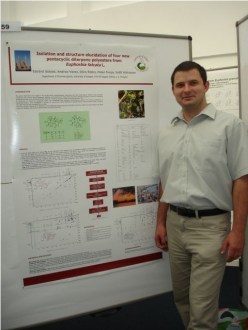 The especially advanced possibilities of complex pharmaceutical research are exploited at the Faculty of Pharmacy, University of Szeged since its different institutes represent the whole area of pharmaceutical research from the synthesis or isolation of biologically active compounds through their pharmacological or biopharmaceutical investigations to their formulation. Students can join different fields of pharmaceutical research according to their interests, at the same time gain wide-ranging knowledge on other fields as well on the available courses. The scientific parts of each program are introduced separately although they represent a single unit.
The especially advanced possibilities of complex pharmaceutical research are exploited at the Faculty of Pharmacy, University of Szeged since its different institutes represent the whole area of pharmaceutical research from the synthesis or isolation of biologically active compounds through their pharmacological or biopharmaceutical investigations to their formulation. Students can join different fields of pharmaceutical research according to their interests, at the same time gain wide-ranging knowledge on other fields as well on the available courses. The scientific parts of each program are introduced separately although they represent a single unit.
Cooperating Institution
Biological Research Center of the Hungarian Academy of Sciences, Szeged
Faculty of Science and Informatics of the University of Szeged
Department of Applied and Environmental Chemistry
Department of Colloid Chemistry
Department of Organic Chemistry
Department of Physical Chemistry
Department of Solid State and Radiochemistry
Faculty of General Medicine of the University of Szeged
Clinics and the Theoretical Institutes
Faculty of Pharmacy, Semmelweis University, Budapest
Faculty of Horticulture of the Corvinus University, Budapest
Department of Medicinal and Aromatic Plants
Faculty of Chemical Engineering of the Technical University Budapest
Department of Organic Chemistry and Technology
Department of Chemical and Environmental Process Engineering
Faculty of Science of the University of Pécs
Department of Botany and Botanical Garden
Faculty of Science of the University of Debrecen
Department of Organic Chemistry
Research Institute of Ecology and Botany of the Hungarian Academy of Sciences, Vácrátót
Plant Protection Research Institute of the Hungarian Academy of Sciences, Budapest
Educational Programmes
1. Pharmaceutical Chemistry and Drug Research
Programme director: Prof. Ferenc Fülöp DSc, MHAS
Institute of Pharmaceutical Chemistry
H–6720 Szeged, Eötvös u. 6., Hungary
Tel.: (+36 62) 545 564, fax: (+36 62) 545 705
E-mail: fulop@pharm.u-szeged.hu
Research programmes
(A) Chemistry of cyclic β-amino acids
Research topics
– Development of new synthetic process for β-amino acids.
– Synthesis of cyclic β-amino acids from terpene derivatives.
– Functionalizations of β-amino acids.
– Synthesis and structure studies of peptide oligomers.
– The use of difunctional synthons on enantioselective catalysis.
Supervisors: Prof. Ferenc Fülöp DSc, Zsolt Szakonyi PhD, Tamás Martinek PhD.
(B) Isoquinoline chemistry
Research topics
– Synthesis of new isoquinolines alkaloid analogs.
– Synthesis of di- and trifunctional tetrahydroisoquinolines.
– Synthesis and stereochemistry of isoquinoline fused heterocycles.
Supervisors: Prof. Ferenc Fülöp DSc., László Lázár PhD.
(C) Enzyme catalysed transformations
Research topics
– Kinetic resolutions of amino acids, 1,2- and 1,3-aminoalcohol derivatives.
– Bakers yeast catalysed transformations of prochiral compounds.
– Dynamic kinetic resolutions, of mono- and difunctional compounds.
Supervisors: Prof. Ferenc Fülöp DSc, Enikő Forró PhD.
(D) Synthesis of 1,3-heterocycles, potential pharmacons
Research topics
– Retro Diels-Alder methodology for preparation of heterocycles.
– Synthesis of 1,3-heterocycles from cyclic β-amino acids and aminoalcohol derivatives.
– Application of heterocycles in enantioselective syntheses.
Supervisors: Prof. Ferenc Fülöp DSc, Prof. Géza Stájer DSc, Zsolt Szakonyi PhD.
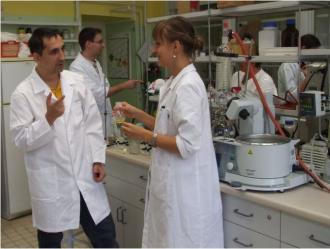 Instrumental background
Instrumental background
The Institute possesses all the modern instruments to aid the synthetic activity. For analytical and spectroscopic characterization of compounds: Bruker Avance DRX 400, 500 and 600 MHZ NMR spectrometer, Perkin-Elmer Paragon 1000 PC FT-IR spectrophotometer; Unicam UV2 UV/VIS spectrometer; Crompack CP-9002 GC; Varian 3900 GC with automatic sample adapter, Perkin-Elmer Autosystem XL GC; Waters HPLC with 600E type pump and 486 type detector; Jasco 870-UV type HPLC detector with Varian 2510 pump; Finnigan MAT 95 S type LC-MS, GC-MS and HRMS instrument; Perkin-Elmer 341 polarimeter. MOE (Molecular Operating Enviroment); Gaussian C3.
Courses
Stereoselective syntheses (Prof. Árpád Molnár)
The course provide a survey of methods of stereoselective tarnsformations including applications of ex-chiral pool building blocks, chiral auxiliaries and catalysts. The utilization of the stereoselective methods in the drug syntheses is also discussed.
Selected topics on organic chemistry (Prof. Ferenc Fülöp)
In the lectures, the most often applied methods of organic synthesis (functional group transformations, synthetic strategies), principles of stereochemistry and conformational analysis, and the chemical aspects of drug research (lead selection and optimization) are discussed.
Basics of computer-assisted drug design (Tamás Martinek)
An introduction to the practical applications of theoretical methods in rational drug design is aimed. Tools of molecular modelling: computer-assisted representation of molecular structure (Z-matrix, coordinate-matrix), molecular graphics; conformational energy, energy map and its determination (ab-initio, semi-empirical methods, molecular force-field models); methods for determination of stable conformations (minimalisation techniques, molecular dynamics, DG (distance geometry), random and systematic search methods); assignment of conformation with the aid of experimental data (Rtg → X-Ray, NMR), search for conditional minimum. Quantitative structure-activity relationships (QSAR): interpretation of functional relationship between measured and calculated physical-chemical parameters and biological activity, notion of predictive force; originating functional relationships and their adaptation to experimental data (minimal square method, partial minimal square, application of neural networks, genetic algorithms); main QSAR models (Hansch-models, CoMFA, Hologram-QSAR).
Chemical biology (Prof. Ferenc Fülöp, György Dormán)
The course shows, how the functions of living cells can be influenced by small molecule xenobiotics; what are the targets and mechanisms of their attacks, what are the methods of target validation, what are the possibilities to modify transcription, what are the methods to study protein-protein interactions. Chemical aspects of genomics and proteomics, as well as methods of diversity-oriented chemical syntheses and microarrays are also discussed.
For courses NMR spectroscopy 1. and 2., see programme „Pharmaceutical analysis”
2. Pharmacodynamics, bioparmacy and clinical pharmacy
Programme director: Prof. György Falkay DSc
Department of Pharmacodynamics and Biopharmacy
H–6720 Szeged, Eötvös u. 6., Hungary
Phone/fax: (+36 62) 545 567
E-mail: falkay@pharm.u-szeged.hu
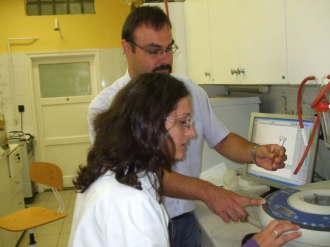 Research programmes
Research programmes
(A) Pharmacology of reproduction.
Research topics
– Pharmacological manipulation of pregnant uterus and cervix focusing on the possible treatments of the premature labor.
– Identification and ontogeny of adrenergic receptor subtypes in the pregnant myometrium (radioligand technique, PCR, blotting assay).
– Assessing contractility and pharmacological reactivity of pregnant myometrium and placental vessels by electric field stimulation.
– Investigation of the adrenergic denervation of the pregnant uterus using electric field stimulation and superfusion technique.
– Investigation of tocolytic substances (adrenergic agonists and antagonists, oxytocin antagonists).
Supervisors: Prof. György Falkay DSc, Róbert Gáspár PhD, István Zupkó PhD
(B) Pharmacology of sexual steroid hormones.
Research topics
– Development of sexual steroids (estrogens, progestins and antiprogestins) by in vitro and in vivo methods. This project targets the elaboration of new, selective active agents.
– Investigation of effects of progestins and antiprogestins on the cervical resistance during pregnancy of the rat.
Supervisors: Prof. György Falkay DSc, Róbert Gáspár PhD, István Zupkó PhD
(C) Investigation of antiproliferative agents.
Research topics
– Development of naturally occurring antiproliferative components obtained from plant extracts.
– Investigation of synthetic steroids – progestins and antiprogestins – as potential agents for hyperproliferative disorders (endometriosis, cancer).
Supervisors: István Zupkó PhD, Prof. György Falkay DSc
(D) Clinical pharmacy.
Research topics
– Methods for improving rational drug use. This topic includes therapeutic drug monitoring of selected antibacterial preparations as well as assessment of interaction risk: genetic polymorphism of CYP-s.
– Pharmaceutical care models for optimizing the chronic drug administration including adherence /compliance assessment, quality of life measurement. Investigation of indicators of rational drug prescribing: problem of polypharmacy.
Supervisor: Assoc. Prof. Gyöngyvér Soós, CSc
Courses
Pharmacology of steroid and peptid hormones (Prof. György Falkay DSc, Res. Prof. Anna Borsodi DSc)
This course includes the discussion and demonstration of the methods used in receptor research, detailed characterization of the main receptor types according to the generally accepted classification (e.g. nuclear receptors, enzyme and G-protein coupled receptors). The emphasis is put on the possible pharmacological influence of the special receptors.
Practical pharmacology of reproduction (Prof. György Falkay DSc)
This course deals with the practical therapeutic possibilities of negative and positive family planning. The most important chapters include oral contraception, induction of ovulation, hormone replacement therapy, tocolysis and pregnancy-associated therapy. The presently used methods in assisted reproduction are additionally discussed.
Selected chapters in pharmacology (Prof. György Falkay DSc, István Zupkó PhD, Róbert Gáspár PhD)
The course discusses the most intensively developing chapters of the pharmacology in a more detailed way as it is possible in the gradual education. In the selection pharmacons or groups are favoured with new mechanism of action, which are not generally used yet. The course is given partly by invited lecturers.
Research methods in pharmaceutical care (Assoc. Prof. Gyöngyvér Soós PhD)
During the seminars relevant examples from the pharmaceutical field will be given including issues dealing with drug utilization and information and the pharmacist’s professional activities.
Pharmacovigilance, pharmacoepidemiology (Assoc. Prof. Gyöngyvér Soós CSc)
Comprehensive overview about the safety problem of drug use in the every day practice.
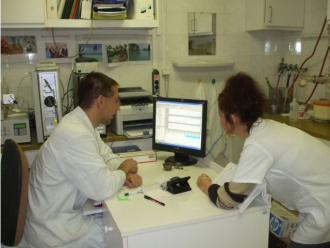 3. Pharmacognosy. Chemical diversity and utilization of plants
3. Pharmacognosy. Chemical diversity and utilization of plants
(Pharmacobotany, Phytochemistry, Utilization of medicinal plants)
Programme director: Prof. Imre Máthé DSc
Faculty of Pharmacy, Institute of Pharmacognosy
H–6720 Szeged, Eötvös u. 6., Hungary
Phone (+36 62) 545 558, fax: (+36 62) 545 704
E-mail: mathe@pharm.u-szeged.hu
Pharmacognosy is one of the oldest sciences, which is in the most direct relation with the natural living world, especially with the plant kingdom, in medicinal treatment, and as such it strives not only to learn about and to utilize the diversity of the plant kingdom as widely as possible, but it also has an interest in its preservation and in the broadest sence with the utilisation of plants. It covers Pharmacobotany, Chemotaxonomy, Phytochemistry, Phytotherapy, Utilization of Medicinal Plants, (bio)technology as main fields. The structure of the program expresses this by its following training programmes: 1. Pharmacobotany, 2. Phytochemistry, 3. Utilization of medicinal plants (phytotherapy).
The program covers disciplines or scientific fields like Classical botany within it plant morphology, chemotaxonomy, biodiversity of medicinal plants, production biology of the active principles, plant physiology (metabolic pathways) allelochemistry, pharmacognosy, cultivation of medicinal plants, plant chemistry (phytohemistry), extraction, separation, instrumental examination of plant substances, description of preparations made from medicinal plants, their manufacturing technology (GMP), phytotherapy, some aspects of pharmacodynamics, drug research, biotechnology.
Research programmes
– Comparative phytochemical investigations, studying the dynamics of accumulation of bioactive substances in medicinal plants
Chemotaxonomic studies: evaluation of chemotaxonomy and production biology of various plant taxa predominantly of those of the temperate belt (Supervisor: Prof. Imre Máthé DSc)
– Isolation and structure determination of biologically active natural compounds. Class of investigated compounds: terpenoids (iridoids, sesquiterpenoids, diterpenoids, triterpenoids, ecdysteroids), alkaloids, phenolic compounds (phenylpropanoids, coumarins, phenanthrenes, flavonoids), essential oil constituents. Investigated plant families: Lamiaceae, Rutaceae, Celastraceae, Euphorbiaceae, Asteraceae, Dioscoreaceae, Ranunculaceae, Amaryllidaceae ( Supervisors: Prof. Judit Hohmann DSc, Assoc. Prof. Zsuzsanna Hajdú PhD)
– Isolation of therapeutically relevant ecdysteroids from plants, elaboration of new methods for analysis of ecdysteroids of plant origin; improvement of chromatographic and spectroscopic analysis (Supervisor: Prof. Mária Báthori, DSc)
The programme is open for pharmacists, diploma chemists, biologists diploma agriculturists, medical doctors, having university degree. It is open for Hungarian and foreign students, speaking Hungarian and/or English and in special cases German languages. Close, everyday relationship with the Research Institute of Ecology and Botany of the Hungarian Academy of Sciences where the richest plant collection in Hungary, including a special medicinal plant collection is available for field experiments.
Courses
Principles of comparative phytochemistry and chemotaxonomy(Prof. Imre Máthé DSc)
Definition of the subject Comparative Phytochemistry: It comprises, beside the general biochemical interpretation, all disciplines applying comparative chemical investigations, or exploiting the results of such approaches. The questions of chemotaxonomy, chemical ecology, physiology of secondary metabolites, general and specific methods of production biology (from sampling, via chemical analyses, to mathematical evaluation of plants and plant chemicals) are the subject of discussions. In addition to the terminology, methodology of chemotaxonomy, examples on the importance of chemotaxonomy at various taxon levels are given. Ecological effects, including human effects and their influences on the secondary metabolites of plants together with the biological importance of secondary metabolites are discussed. Importance of the preservation of biodiversity that of the endangered species is justified. Cultivation of plants, breeding, processing technologies are discussed on comparative chemical bases.
Phytochemistry (Prof. Judit Hohmann, DSc)
The course deals with the general and specific knowledge on natural compounds, including the biosynthesis, metabolism, accumulation, structural characteristics, physical, physicochemical properties of primary and secondary plant metabolites. The chemical synthesis, analytics of natural products and examples of semi-synthesis and microbiological transformation are also presented. The generally applied methods of phytochemistry and principles of structure determination of natural compounds are discussed. The main groups of natural metabolites are as follows: carbohydrates (mono-, oligo- and polysaccharides), amino acids, peptides and proteins, lipids, nucleosides, nucleotides, nucleic acids, isoprenoids (mono-, sesqui-, di-, tri-, tetra- and polyterpenes), steroids, phenolic compounds (phenylpropanes, phloroglucin-, hydroquinone derivatives, coumarins, lignanes, flavonoids, anthranoids, tannins), alkaloids, biogen amines, vitamins, hormons, plant toxins, micro- and macroelements.
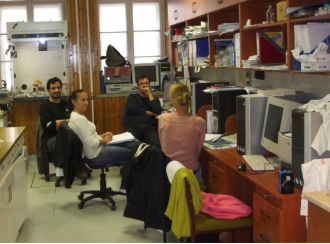 Applied botany and pharmacognosy (Zsuzsanna Hajdú PhD)
Applied botany and pharmacognosy (Zsuzsanna Hajdú PhD)
Medicinal plants are used for therapeutic purpose as tea drugs, as preparates made from them, and as pure compounds isolated from the plants. In addition several plants have importance in different fields beside the medicinal use. The knowledge of the optimal conditions of the production of the crude drug and the quality assurance, and the standardization of the products is very important. Studies on the influence factors affecting the production and the quality are essential. Topics: Medicinal use of plants on the basis of their known pharmacological activity and their therapeutic value; Use of the medicinal plants for different purposes (in the food industry, in cosmetics, chemical industry for households, as insecticides); Possibilities and methods of quality control and quality insurance.
Modern phytochemical methods, separation techniques (Prof. Mária Báthori DSc)
The course deal with the methods used in the phytochemistry, such as extraction, separation techniques, isolation, qualitative and quantitative examination of the plant constituents. The identification, the purity-control and structure elucidation of biologically active compounds will also be discussed. Topics are as follows: extraction (Liquid-liquid and solid-liquid extraction), Chromatography (elements, nomenclature), column chromatography (CC), HPLC, planar chromatography (TLC, OPLC, rotation planar chromatography), size excursion chromatography, displacement and affinity chromatography, capillary electrophoresis, distribution methods (Craig separation, DCCC), preparative chromatography, quantitative determination of plant constituents, sample preparation, validation, detection (on-line and off-line methods).
Botanical practice on medicinal plants (Prof. Imre Máthé, DSc, László Tóth CSc)
This course includes the following topics: Knowledge of medicinal plants in practice; Modern plant systems and their application in the practice of pharmacogosy; New taxonomic methods and their utilisation for the identification of medicinal plants; Identification of plants in laboratory and in nature (in practice); Important plant families, genera of medicinal plants and their morphological characteristics; Introduction of modern propagation techniques of medicinal plants; Collection/cultivation of medicinal plants in the light of plant protection (nature conservation); Ecology of medicinal plants.
Instrumental background
In the Institute modern instruments for phytoanalytical work and isolations of natural compounds are available: High pressure chromatography (analytical and semipreparative HPLC) with UV, PDA and refractive index (RI) detections; Centrifugal planar chromatography (RPC); Liquid-liquid separation chromatography (e.g. DCCC); Gas chromatography (GC) with mass spectrometric (MS) and flame ionisation detectors (FID); TLC densitometer with UV/VIS detection; Ultraviolet/Visible spectroscopy (UV/VIS); Common chromatographic techniques (TLC, CC, flash chromatography).
4. Pharmaceutical technology
Programme director: Prof. Piroska Szabó-Révész DSc
Department of Pharmaceutical Technology
H–6720 Szeged, Eötvös u. 6., Hungary
Phone: (+36 62) 545 572, fax: (+36 62) 545 571
E-mail: eros@pharma.szote.u-szeged.hu
Pharmaceutical technology is one of the most dynamically developing fields of pharmaceutical sciences. Its importance lies primarily in the fact that however promising a drug is, it can be used in therapy only in an appropriate form, that is after formulation. Proper formulation is the prerequisite to bioavailability. Thus pharmaceutical technology is not only a modern, important and interesting applied science but it is also responsible for the success of therapy to a great extent.
There are two basic research directions in modern pharmaceutical technology today:
1. to improve the properties (mainly solubility) of the active ingredient,
2. to plan new drug delivery systems (therapeutic systems) with better bioavailability
Based on this, the doctoral program also consists of two major elements: the improvement of drug properties with solubilization, microencapsulation, molecular encapsulation and spherical crystallization, and the planning of new solid and semi-solid drug delivery systems.
Research programmes
(A) Improvement of the properties of drugs with incorporation in micro- and nanoforms, the planning of new colloidal drug delivery systems
– solubilization of new drugs,
– microencapsulation of drugs,
– production of nanoparticles from drugs,
– production of niosomes, incorporation of drugs in niosomes,
– production of drug delivery systems with complex emulsion base,
– production of drug delivery systems with microemulsion and liquid crystal base
– ex vivo tests with human and animal samples
Supervisors: Prof. I. Erős DSc, E. Csányi. PhD, S. Berkó PhD
(B) Research-development in the field of tablets and coated tablets
– technological improvement of granulation and pelleting proceeding tableting
– improvement of the flow properties of powders and granulated products by means of coating the crystals and granules and with the use of additives
– morphological, rheological and thermoanalytical examination of treated and untreated crystals and granules
– examination of the coating effect on different preparations
– study of the energy parameters during tablet preparation
– development of new coating methods
– improvement of drug dissolution
– multiparticular systems
– controlled drug delivery systems with technological methods
Supervisors: Prof. K. Hódi DSc, P. Kása PhD, G. Regdon PhD.
(C) Improvement of physicochemical properties of drugs with crystallization, amorphization. Screening of polymorph modification of active agents.
– Investigation of the thermal behaviour of active materials (DSC, TG-MS)
– Investigation of structure of drug materials (XRPD, RAMAN, NIR)
– Improvement of solubility, dissolution rate and permeability of active agents
– Pulmonary and nasal drug delivery systems
Supervisors: Prof. P. Szabó-Révész DSc, Z. Aigner PhD, R. Ambrus PhD, A. Szűts PhD
(D) Novel aspects of quality assurance in the development of medicinal products: determination of key process parameters for control and validation. Analysis of the impact of regulatory measures on the development, application and consumption of medicines
Supervisor: Prof. Tamás Paál CSc
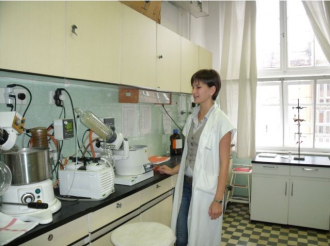 Courses
Courses
The optional courses advertised by the Institute are partly related to the research fields investigated in our Institute (e.g. pharmaceutical rheology, stability of disperse and coherent systems, modern solid and colloidal drug delivery systems), and partly to the main directions of development of pharmaceutical technology (e.g. therapeutic systems). The primary principle in organizing optional courses has been (so far) to enable the students to collect the necessary credit points by the end of the second year so that they can devote all their energy to writing their thesis and publications during the last year.
We took care to provide the student with the possibility to continue his/her student research topic and to make use of the methodology and expertise in approach already acquired, and another consideration was that the work load of the assistant consultants should be uniform, if possible.
Pharmaceutical rheology (I. Erős, E. Csányi, K. Hódi)
A two-semester course, with 15 x 2 hours per semester. The rheological properties of major dosage forms (colloidal solutions, emulsions, suspensions, creams, gels, ointments, powders), modern examinations methods (e.g. creep test, elasticity measurement) and the rheological aspects of important technological operations (mixing, grinding, pressing) are presented in the lectures.
Stability and stabilization of disperse and coherent systems(I. Erős,. P. Szabó-Révész,. K. Hódi, Z. Aigner)
The course lasts for 1 semester, 15 x 3 hours. The most important topics of the lectures are: thermodynamic and kinetic stability, stability of the dispersity degree on and distribution, stability and stabilization of composed preparations, decomposition-selective analytical methods, HPLC, DSC, execution of accelerated stability examinations, determination of expiry.
Relationship between pharmaceutical technology and therapeutic effect(I. Erős,. K. Hódi,. P. Szabó-Révész)
It is a two-semester course, 15 x 3 hours per semester. The following major topics are dealt with during the course: the LADMER system, technological possibilities of prolonged release, technological possibilities of controlled release, technological solutions of targeting drugs, technological solutions of pulsatile release, therapeutic systems for systemic use (infusion systems, transdermal therapeutic systems, oral therapeutic systems, rectal therapeutic systems, implantable pumps), therapeutic systems for local use (ocular therapeutic systems, uterine therapeutic systems), biological computers.
5. Pharmaceutical Analysis
Programme director: Prof. György Dombi CSc
Institute of Pharmaceutical Analysis
H–6720 Szeged, Somogyi u. 4., Hungary
Tel.: (+36 62) 545 804, fax: (+36 62) 545 806
E-mail: g.dombi@pharm.u-szeged.hu
Co-operating institutions
Institute of Mechanical and Process Engineering, Faculty of Engineering
H–6724 Szeged, Mars tér 7., Hungary
Tel.: (+36 62) 546 580, fax: (+36 62) 546 049
e-mail:rajko@mk.u-szeged.hu
Institute of Chemical Informatics, Faculty of Education
H–6722 Szeged, Boldogasszony sgt. 6., Hungary
Tel.: (+36 62) 544 720, fax: (+36 62) 420 953
e-mail:viskolcz@jgypk.u-szeged.hu
Research programmes
1. NMR Spectroscopy
Research topics
– Development of experiments in 2D NMR spectroscopy.
– Structure elucidation of organic molecules (natural products, steroids, peptides, etc.).
– Multinuclear spectroscopy of organometallic and complex compounds
– Use of statistical methods to evaluate complex mixtures (body fluids, natural products etc.
– Theoretical calculation of spectral parameters
Supervisors: Prof. György Dombi CSc, Péter Forgó PhD
2. Atomabsorption spectroscopy
Research topics
– Determination of trace elements in biological systems (bones, body fluids, etc.)
– Metals in pharmaceutical preparations
– Spectroscopy of environmental samples
– Statistical evaluation of spectroscopic data
Supervisors: Prof. György Dombi CSc
3. X-ray crystallography of proteins
Research topics
– Isolation, purification of peptides and proteins.
– Crystallisation of peptides and proteins.
– Calculation and evaluation of spectroscopic data.
Supervisors: Prof. György Dombi CSc, Assoc. Gerda Szakonyi PhD
4. Chemometry
Research topics
– Calculation of spectroscopic data.
– Development of algorithms on molecular similarity
– Data compression, data mining, expert programs.
– High performance computation
Supervisors: Prof. György Dombi CSc, Assoc. Prof. Imre Bálint CSc, Assoc. Prof. Róbert Rajkó PhD, Béla Viskolcz PhD
Instrumental background
The Institute possess a BRUKER AVANCE DRX 500 and DRX 600 NMR spectrometer, equipped with multinuclear probeheads, gradient coils, variable temperature units, and corresponding computers, software etc.; a Prekin Elmer 420 atomabsorption spectrometer with 17 lamps for different elements, flame and graphite furnace atomization. We have the corresponding laboratory equipments, small instruments to perform research. X-ray measurements are made in international cooperation.
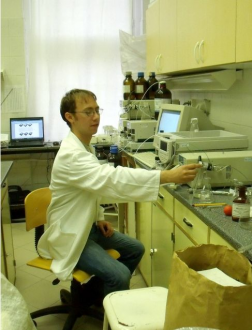 Courses
Courses
NMR spectroscopy 1, 2. (Prof. György Dombi CSc)
Different spectroscopic methods. Theory of NMR spectroscopy: nuclear spin, nuclear magnetic moment. Larmor precession. Description of the resonance in laboratory and in rotating frame, Bloch equation. CW and pulse (FT) spectroscopy. Measurement of different nuclei. Chemical shift, indirect coupling constant, couplings. Chemical and magnetic equivalence. Informations on chemical structure. Relaxation. Nuclear Overhauser effect. Evaluation of simple spectra. Modern pulse NMR methods. Experiments using several pulses (rotating frame description). Two and multidimensional experiments. Evaluation of complicated spectra. Special technics: two and more dimension measurements, correlation spectroscopy, time-dependence, solid state nmr spectroscopy, mathematical methods in spectrum evaluation and simulation, chemical methods in nmr spectroscopy. Measurements on conformation, equilibriums, solvent effects, complexations. Structure of nmr spectrometer. Measurement, data aquisition methods of data transformations. During the course the students will have opportunity to measure their own sample on the 500 and 600 MHz NMR spectrometers. They will visit the MRI instrument at the Radiological Clinic of the University too.
Chemometric methods in pharmaceutical research (Róbert Rajkó PhD; Prof. György Dombi CSc)
Basic chemometric methods: principal component analysis (PCA), principal component regression (PCR) and partial least squares (PLS) methods. Evaluation of several dimension datasets received with coupled methods (e.g. HPLC–UV-Vis DAD, HPLC–NMR, HPLC–FT-IR, GC–MS etc.): use of complicated chemometric methods, like: trilinear decomposition (TLD), parallel factor analysis (PARAFAC), self-modeling curve resolution (SMCR). During the course the students will solve problems by evaluating datasets from the fields of pharmaceutical analysis, spectroscopy or pharmaceutical technology. We have a study book in Hungarian too: Horvai Gy. (Editor.): Sokváltozós adatelemzés (kemometria). Tankönyvkiadó, Budapest, 2000.
Introduction into the basic molecular modeling (Béla Viskolcz PhD; Prof. György Dombi CSc)
The aim of the course to give an introduction into the interactions determining the biological structure: peptide bond determining the structure of peptides, phosphoric ester bond determining the structure of nucleic acids, the ether bond determining the structure of polysaccharides and triglyceride structure elements determining the structure of membranes. The importance and role of the secondary interactions (H-bond, dipole interactions, etc.) in the determination of macroscopic structure of biopolymers. Introducing strain conditions received from instrumental analysis of the compounds (nmr, X-ray diffraction, ORD-CD, etc.) in the complete structure determination. Part of the course is the chemical informatics as an interdisciplinary field of the structure determination: understanding of the chemical and biological changes by quantumchemical methods. Quantum chemistry – as an universal "instrument" to study structure and reactivity. Examples for biochemical problem-solving. Quantummechanical base of chemistry and biology. Typical double-rotor potential energy surfaces. Achiral and chiral Ramachandran potential energy surfaces. The problem of the backbone and side group conformations of peptides: the possible separation of the two variables. Conformation of dipeptides and oligopeptides. Secondary structure of peptides as model for the structure of proteins. Drug design: modeling of the interactions; docking experiments; description of similarity. There is a possibility to perform own modeling experiments on the HPC system.
Basic structural biology – New possibilities in design of drug molecules (Gerda Szakonyi PhD; Prof. György Dombi CSc)
General introduction to the proteins: formation, their role, structure. Overview of the main secondary and tertiary structures. Use of X-rays and nmr spectroscopic methods for the three-dimensional structure elucidation of macromolecules. Synthesis of targeted proteins with recombinant DNS method. Important protein expression systems. Synthesis of labeled proteins: Se-Met, 13C, 15N. Separation technics. Purification of proteins: affinity chromatography, separation by molecular mass, separation by charge, reversed phase chromatography. Crystalisation of proteins. Technics and methods of crystalistaion. Crystal classes of proteins. Basic X-ray crystallography. Importance of synchrotron sources. Structure determination I. Problems of the phase. Structure determination II. Theory and practice of unusual scattering. Atomic absorption coefficient. Structure determination III. Molecular substitution. Membrane proteins: structure, effect, biological role. NMR – determination of the structures of macromolecules under physiological condition, in solution.
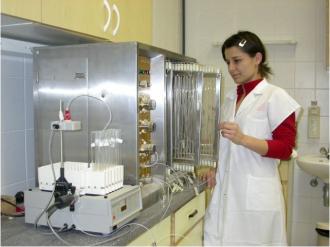 Molecular similarity and its use in pharmaceutical research (Imre Bálint PhD; Prof. György Dombi CSc)
Molecular similarity and its use in pharmaceutical research (Imre Bálint PhD; Prof. György Dombi CSc)
Description of the similarity of the chemical/physical behaviour of molecular systems is very difficult: one usually using intuitive definitions: therefore it is not unified and not well defined.. The definitions using different mathematical methods using abstract algebra, topology, algebraic topology, functional analysis are expressing mainly the differences in the similar properties. The similarity plays an important role in the molecular drug design: based on the mathematical evaluation of the comparison of the quantumchemically relevant properties. The course gives a detailed introduction into the problems of molecular similarity.
Spectroscopic methods in chemical structure elucidation (Prof. György Dombi)
The whole range of spectroscopic methods will be described during the lectures: absorption, emission spectroscopic methods; NMR, ESR, MW, IR, UV-VIS, X-ray (absorption, fluorescency, diffraction), AA, etc. The theory, information content of the spectra, experimental methods will be described. Qualitative description of the different spectroscopic methods: rotational, vibrational and electron spectroscopies. Evaluation of individual spectra and combination of different methods. Mathematical and statistical methods in the evaluation of spectra. Structure of the spectrometers: single beam, double beam, FT spectroscopy. The role of computers, digital methods in the spectroscopy. Quantitative spectroscopy: Beer's law and its use. Accuracy and sensitivity of different measurements. Measurement of several components in a mixture. Statistical error of the measurement.
Representative dissertations (title, author, supervisor, year):
- Enzymatic kinetic resolution of β-amino and β-hydroxy acid derivatives, Magdolna Solymár, Ferenc Fülöp, 2005
- Investigation of dynamic processes and self-organization by spectroscopic methods and molecular modelling,Anasztázia Hetényi, Ferenc Fülöp, 2005
- Applications of β-oxocarboxylic acids and amino acid derivatives for the preparation of heterocycles; retro Diels-Alder reaction, Ferenc Miklós, Géza Stájer, 2005
- Syntheses and ring-closures of difunctional tetrahydroisoquinolines, Zita Zalán, Ferenc Fülöp, 2006
- Mass spectrometric behaviour of phosphorus-containing heterocycles and ring-chain tautomerism of some 1,3-O,N-heterocycles, Márta Juhász, Ferenc Fülöp, 2008
- Enzymatic kinetic resolution of β-amino acid derivatives, Mónika Fitz, Enikő Forró, 2009
- Syntheses and applications of novel beta-amino acids, Szilvia Gyónfalvi, Zsolt Szakonyi, 2009
- High-performance liquid chromatographic separation of the enantiomers of amino compounds on chiral stationary phases, Anita Sztojkov-Ivanov, Ferenc Fülöp, 2009
- Role of the adrenergic system in regulation of the resistance of the cervix of pregnant rat, Zoltán Kolarovszki-Sipiczki,George Falkay, 2007
- Antitumour effect of plant extracts and their constituents on cancer cell lines, Borbála Réthy, George Falkay 2008.
- Analysis of Hungarian hospital antibacterial use from differenc aspects, Ria Benkő, Gyöngyvér Soós, 2009
- An investigation of the effects of beta(2)-mimetics, gestagens and an alpha(2)-antagonist in premature labour model in the rat, Márta Gálik, George Falkay, 2009
- One step closer to the role of the brain CB(2) cannabinoid receptors: interaction with the μ-opioid system, Eszter Páldy, Anna Borsodi, 2009
- Antidepressant consumption in Hungary and health-related quality of life assessment in patients with depression, Réka Viola, Gyöngyvér Soós, 2009
- Isolation and structure elucidation of diterpenes from Hungarian Euphorbia species, Andrea Vasas, Judit Hohmann, 2006.
- Investigation of the diterpene alkaloids of Aconitum species native to the Carpathian Basin, Dezső Csupor, Judit Hohmann, 2007.
- Analysis of the ecdysteroid profile of Serratula wolffii roots, Erika Liktor-Busa, Báthori Mária, 2008.
- Comparative chemical analysis of Ballota species, with special respect to Ballota nigra, our new official plant in Ph. Hg. VIII, Enikő Tóth, Imre Máthé, 2009
- Isolation and structure elucidation of compounds with antitumor activity from Tamus communis and Xanthium italicum, Adriána Kovács, Judit Hohmann, 2009
- Formulation and investigation of in situ gelling lyotropic liquid crystalline systems, András Fehér, István Erős, 2006
- Comparison of the effect of granulation and drying techniques on the quality of a pharmaceutical product with a high active ingredient content, Ágota Hegedűs, Klára Hódi, 2007
- Application of non-conventional methods in the physico-chemical processing of pharmaceutical biopolymers for the aim of drug formulation, Anikó Szepes, Piroska Szabó-Révész and J. Ulrich, 2007
- Enhancement of the dissolution of meloxicam in binary systems, Parya Reisi Nassab, Piroska Szabó-Révész, 2007
- The study of physico-chemical properties of crystalline and amorphous materials, Ágota Gombás, Piroska Szabó-Révész, 2008
- Structural evaluation of w/o/w multiple emulsions, Anita Kovács, István Erős, 2008
- Dropping method as a new possibility in preparation, Amir Bashiri Shahroodi, Piroska Szabó-Révész, 2008
- In vitro and in vivo evaluation of semisolid dosage forms for transdermal application of Ketamine, George Zapantis,István Erős, 2008
- Formulation optimization of ammonio methacrylate copolymer based sustained release micropheres, Péter Sipos, István Erős, 2008
- Study of the applicability of sucrose esters in hot-melt technology, Angéla Szűts, Piroska Szabó-Révész, 2009
- Targeting pharmacons to the brain via the nasal pathway, Sándor Horvát, Mária Deli, 2009
- Formulation and Investigation of Gel-Emulsions Containing Polymeric Emulsifiers, Mária Budai-Szűcs, István Erős, 2009


 Print article
Print article Send link
Send link Share
Share
